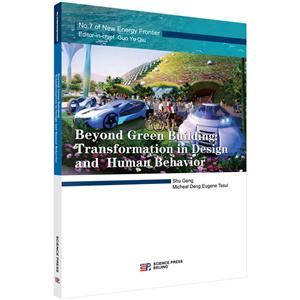绿色节能建筑(英文版) 版权信息
- ISBN:9787030447241
- 条形码:9787030447241 ; 978-7-03-044724-1
- 装帧:一般胶版纸
- 册数:暂无
- 重量:暂无
- 所属分类:>
绿色节能建筑(英文版) 内容简介
Shu Geng、Micheal Deng Eugene Tssui著的《Beyond Green Building--Transformation in Design and Human Behavior》讲述了:Architects Michael Deng and Eugene Tssui present the current and anticipatoryevolution of ecological thinking as applied to the built environment and human behav-ior change. We are given the current societal outlook of a LEED ( Leadership in Ener-gy and Environmental Design ) -based paradigm (Part I) and the proceed to investi-gate the coming sociological issues that are profoundly effecting our society andculture resulting in an emotional/behavioral motivations and needs (Part II) . Rarely does a book cover the deeper motivations of the human psyche and howthat directly influences our designed, built, environments. This pioneering book covers the gamut of human behavior, i.e. , the growingepidemic of global obesity, the pervasive presence of bullying in all walks of life, andthe irresponsible treatment of the earth and its resources. This is a pioneering work thatdares to tread where others fear to go.
绿色节能建筑(英文版) 目录
- >
李白与唐代文化
李白与唐代文化
¥11.9¥29.8 - >
巴金-再思录
巴金-再思录
¥14.7¥46.0 - >
罗曼·罗兰读书随笔-精装
罗曼·罗兰读书随笔-精装
¥31.9¥58.0 - >
中国历史的瞬间
中国历史的瞬间
¥16.7¥38.0 - >
二体千字文
二体千字文
¥14.0¥40.0 - >
龙榆生:词曲概论/大家小书
龙榆生:词曲概论/大家小书
¥7.7¥24.0 - >
烟与镜
烟与镜
¥14.4¥48.0 - >
大红狗在马戏团-大红狗克里弗-助人
大红狗在马戏团-大红狗克里弗-助人
¥4.4¥10.0
-
中国传统民俗文化:建筑系列:中国古代宫殿
¥23¥58 -
中国传统民俗文化:建筑系列:中国古代楼阁
¥23¥58 -
中国传统民俗文化:建筑系列:中国古代砖瓦
¥23¥58 -
广联达计价应用宝典——基础篇
¥52¥68 -
从117到中国尊-姚攀峰工程实践及前沿研究
¥18.7¥49 -
国外城市规划与设计理论译丛整体城市主义
¥20.7¥58





















